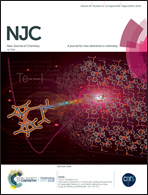Pd/meso-CoO derived from in situ reduction of the one-step synthesized Pd/meso-Co3O4: high-performance catalysts for benzene combustion†
Abstract
The chemical state of Pd plays an important role in the catalytic combustion of volatile organic compounds (VOCs). In this work, we adopted a novel one-step modified KIT-6-templating strategy with nitrates of cobalt and palladium as the metal source to successfully synthesize the three-dimensionally ordered mesoporous Co3O4-supported Pd nanoparticles (0.85 wt% Pd/meso-Co3O4, denoted as 0.85Pd/meso-Co3O4). The 0.93 wt% Pd/meso-CoO (denoted as 0.93Pd/meso-CoO) and 1.08 wt% Pd/meso-Co–CoO (denoted as 1.08Pd/meso-Co–CoO) samples were prepared via in situ reduction of 0.85Pd/meso-Co3O4 in a H2 flow at 200 and 350 °C, respectively. Among these samples, 0.93Pd/meso-CoO exhibited the highest catalytic activity for benzene combustion (T50% = 167 °C and T90% = 189 °C at a space velocity of 40 000 mL (g h)−1). The chemical state of Pd on the 0.93Pd/meso-CoO surface was metallic Pd0, which favored oxygen activation to active adsorbed oxygen (Oads) species, hence rendering this sample to possess the largest desorption of Oads species below 400 °C. The intermediates of formate, acetate, maleate, and phenolate were generated via the interaction of benzene and Oads species. We conclude that the excellent catalytic performance of 0.93Pd/meso-CoO was related to the mainly formed Pd0 species, good oxygen activation ability, and high surface area.



 Please wait while we load your content...
Please wait while we load your content...